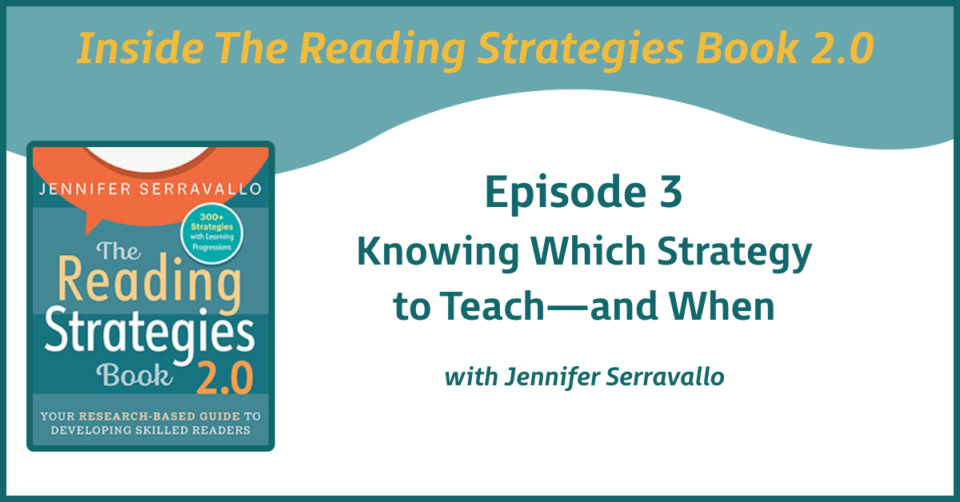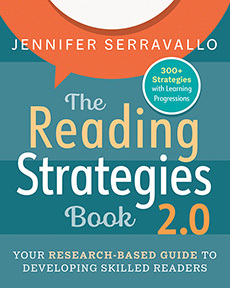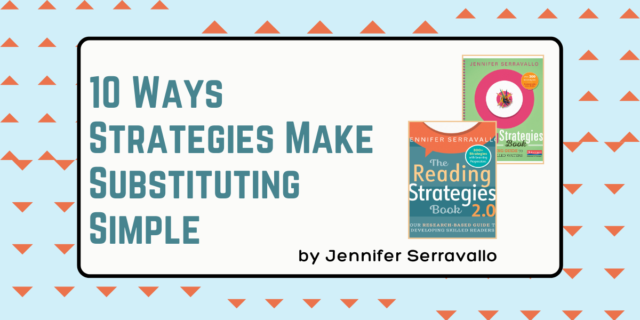
In the third installment of our three-part series Jen Serravallo, we explore how her work in The Reading Strategies Book 2.0 supports differentiated instruction. Jen shares how educators can use student data, lesson objectives, and skill progressions to select targeted strategies that meet diverse learning needs.
This episode focuses on applying strategies across the learning continuum—from early decoding to advanced analysis—and emphasizes how purposeful, goal-driven decisions can enhance instruction in phonics, main idea, and vocabulary development.
In this episode, educators will learn:
- How to use The Reading Strategies Book 2.0 to align strategies with student goals and skill levels.
- Ways to apply multiple strategies flexibly across different reading scenarios.
- Specific examples of strategies for:
- Phonics instruction
- Main idea development
- Vocabulary acquisition
- How to make data-informed instructional choices that support differentiation.
- The role of strategy selection in fostering student independence and deeper comprehension.
TRANSCRIPT
Brett Whitmarsh:
So Jen, in our previous podcast episodes, we've talked about the research inside The Reading Strategies Book 2.0. We've talked about how it can fit inside any curricular program, but how does a teacher start off? How does a teacher know what strategy to pick and when for a student?
Jennifer Serravallo:
Yeah, remember back to the first episode how I talked about how strategies are always a way to get to a goal, right? Strategies are not an end in and of themselves, but we teach them for a reason. I mean, one of the reasons is just generally to teach kids to be active readers, but another is we want to help them to do something better. And so I've organized the book according to goals. The first edition was also organized according to goals because I think that a goal-directed focus makes the most sense. In the last episode, we talked about how I might look at my state standards and look at the goal and the state standard, and that goal can match up to the goal chapter in The Reading Strategies Book. And then I can go in more detail into the skill progression and then find the specific strategy.
We also talked about core programs. I can look at my lesson objective or the objective for the module, look at that objective, match that up to one of the goals in The Reading Strategies Book, zoom into the skill progression, and then further find the specific strategies that I'm going to teach kids, which offer me the specific language. Yet, another way that we haven't talked too much about is to start off with the students themselves. Look at their work, right? Look at your assessment data. Maybe you're using i-Ready or BAP or maybe you have some formative assessments you've created yourself in the classroom. Look at the data, look at the results, observe the students and see what you notice and then say, "Okay, given what I'd just observed, or given what this assessment told me, I know the student needs help with retelling. I know the student needs help with understanding vocabulary words.
I know the student needs help with figuring out the main idea." I think the goals in the strategies book are going to be very familiar to people, the words you see again and again and again to describe the kinds of things we want readers to be able to do. Then once you say, "Oh, I know this child needs help decoding words, right? They're constantly stumbling over words when I listen to them read, they're making guesses at words. They're looking at the pictures instead of looking at the words. That's a sign. This is a student that could be helped with some strategies for figuring out the words in their books." Then you'll turn to the chapter called accuracy. You'll go to the beginning of the chapter and you'll find a skill progression, and then that skill progression, as I mentioned in the last episode, has an if, then format and the if is meant for teachers to kind of scan and say, which of these most sounds like my student? Right? So I'll read from the accuracy one. The first condition is needs support tracking the print. The next one is, has begun decoding and is ready to practice self-monitoring and correcting, right? This is the kid who's making mistakes and continues moving on and doesn't go back and fix them. The next one, they're attempting to decode unfamiliar words. They're going left to right. They're blending letter by letter, but they need to be a little bit more flexible with sounds. So they need to try different vowel sounds for example, or understand how different letter combinations work together.
And then eventually the last stage or the last step on the skill progression is being ready to decode longer multi syllabic words and being more flexible with more complex letter strings, or applying their knowledge of morphemes to their word reading as well. So the teacher would listen to the student read, maybe look at the errors they're making and say, "Okay, it sounds like what's happening here is the child is just kind of zooming through.They're not self-correcting, not monitoring, they're just trying to get through the passage as quickly as possible. So I'm going to go to that, what is it, that second scenario, and I'm going to look to the right hand column." Then you might teach, it says, and then there's five strategies there that can help a child who's needing to slow down, monitor their reading and go back and attempt to self-correct. So for example, one is called fix it by checking each letter where you prompt the child to go back to the word that they didn't read correctly and go through letter by letter, say the sounds, and then blend the sounds together. Of course, they need phonics knowledge too. They're not going to be able to say those sounds correctly unless they know something about letter sound correspondence. But this is just a step-by-step reminder of how do I fix anytime I make a mistake? What are the steps I can follow and do again and again.
Brett:
Could you now do an example of a strategy for finding the main idea?
Jen:
Yeah, let me zoom out and talk about the skill progression, and then I'll zoom in and talk about a specific strategy. So when you think about main idea, one of the things I think about a lot is how complex is the text? And in some ways, that drives the strategies I'm going to be offering, and it's one of the reasons why there's so many strategies for figuring out the main idea. There's 20 in this chapter. It's because as texts get more complex, we need new how-tos to be able to deal with the complexity. Think about a text you might see in a first grade classroom that says, "All about whales", and then every page is a different fact about whales, and you say, "What's this book mostly about?" And they say, "Whales", and you're like, "You nailed it." It's not that hard to figure out what it's mostly about. This chapter is actually called main topics and ideas because in earlier levels or earlier more simplistic texts, it's really about a topic that more than an idea.
But then think about the text that a 10th grader is reading in history class. You're not just going to say, this is about the American Revolution, you've got to get a little bit more specific than that. And you should have an angle or an idea about that topic, and you have a lot more information to deal with and text features and photographs and timelines and sections and subsections, and so when the text gets more complex, I need a new approach. I need a new how-to, I need to do something a little bit different. So I think if you look at the main idea, skill progression, you're going to see it sort of follows that logic in a way. So the first one is, names a topic and is ready to think about subtopics. Okay, so the whole book's about whales, this part's about what whales eat, this part's about how whales swim, this part's about how whales take care of their babies, something like that.
The next section on the scale progression is about how kids are able to identify topics and subtopics, and they're ready to just find a main idea in the text. Freddie Hebert, researcher who has a website called TextProject.org, she talks a lot about text complexity and text types. She talks about this concept of a considerate text. A considerate text is one that really tells you what is it mostly about, and you can find the main idea in the text, and younger readers often have texts that are considerate. They will tell you what the main idea is, you just need to know where to look for it. Like looking at main idea sentences or topic sentences or looking for introductions and conclusions, for example, so we want to clue kids into that. But then they start reading harder texts where you can't just find a main idea, you have to infer it. That's what that next chunk is about, on the skill progression.
So you're able to recognize a main idea. You know what a main idea sounds like, looks like, you can pick it out of a lineup, but if it doesn't tell you straight out in the text what the main idea is, can you infer it? Can you figure it out on your own by putting together the information and figure it out? So strategies in that section like, oh, I use this all the time with kids of all ages, paraphrase each chunk, then put the pieces back together as one of the strategies. So this one is you basically stop at a chunk, it could be like a paragraph or it could be a visual chunk on the page, and you write a quick note to yourself. You write a keyword, a phrase, or even draw a little picture, and then you read the next chunk and do it again. Read the next chunk, do it again, and then you put it all together to try to say, "Okay, so now what's it mostly about?"
The next chunk is about determining main idea when the text complexity and structure is challenging. So there's a whole suite of strategies, there's five of them there to how do you figure out the main idea when it's a problem, solution structure. How about when it's a cause and effect structure? How about when it's a compare, contrast, structure, and so on. And then the last section on this skill progression is really for kids that are really able to do more analysis, they get what a main idea is, but now they're thinking about critically analyzing author's craft, thinking about author's authority or bias. And this whole section is, these are all new strategies to this edition. I tried to really add in this chapter and across all chapters, some more strategies for advanced readers, middle school readers, early high school readers.
Brett:
Yeah. And that's critically important right now that we need that as well. All right, let's do one more.
Jen:
Okay.
Brett:
How about a strategy for building vocabulary knowledge?
Jen:
So the research around vocabulary is really interesting, or teaching strategies and vocabulary. I look a lot at Tanya Wright's research here. One of the things that the researchers have found when it comes to vocabulary strategies is that teaching one or two actually doesn't get you very far, doesn't do very much for you. You need a suite of strategies as a reader. You need to have a flexible toolkit of different ways to approach words, and that's probably because as you counter different kinds of words, or this chapter also covers figurative language, you need different strategies for different situations. Sometimes the definition of a word might be right there in the text, and you just need a strategy to know, oh, when there's m dashes or commas offsetting a definition, I know that that's what that word means, but that doesn't always work. Sometimes there isn't a definition.
So I can't use that strategy. I have to use a different one. Maybe using my knowledge of morphology, like prefixes, suffixes, base words, root words, maybe that's going to help me in this situation. I'll try that one. So you need to have a toolkit. You need to try different tools for different challenges. So the skill progression in this chapter starts off with just basically trying to develop word consciousness and awareness. Getting kids to be curious like, "Hey, you're reading this book? You like this story. Well, guess what? There might be some words in here that you have never heard before, and if you pay attention and you are curious about it, you can learn what these new words are." So there's a few strategies to help with that. The next one is if a student is aware that the word's unfamiliar and they're just trying to get a gist so that their reading isn't interrupted and they keep going just from sentence level context, what are some strategies for that?
So I've got seven strategies there of how do I use sentence level context to figure out just a basic gist or a simple definition of what that word is so I can continue my reading. Then the next set of strategies, there's four here. Ask kids to call up their knowledge of grammar, morphology and or etymology to be able to figure out what those words mean. So there is, again, like I said before, affixes like suffixes, prefixes, roots, bases, but also cognates like where else have I... If I can speak a language other than English and I'm reading in English, do I know any words in my other language that look like this word sound like this word could help me figure out this word? Then there's a set of strategies that would help kids to use outside resources, like references, other friends who might know what the meaning of the word is, dictionary, things like that. I have that further down in the skill progression because I don't want that to be the first go-to.
Brett:
Yeah.
Jen:
I want kids to stay in the text they're reading and only consult outside because it really interrupts your reading. If you think about it and slows you down.
Brett:
Yeah, it takes you out of the moment.
Jen:
It takes you out of the moment maybe unless you're reading on a Kindle or something, you just [inaudible 00:13:23] see it right there. But in a lot of cases, if you're reading, it would interrupt your reading for several minutes to go look it up. And then the last collection of five strategies on the skill progression really is about, again, the higher level thinking and analysis. So we're thinking about author's choice of words, a deeper understanding. Why did the author choose this word? Why didn't they use a different word? What is kind of the nuanced meaning in this text, in this particular context? So that's sort of a higher level analysis kind of thinking. And then again, there's like five strategies there.
So all these skill progression examples I gave you, Brett, whether we're talking about the accuracy chapter, the main idea chapter, the vocabulary and figurative language chapter, they're organized in such a way to be thinking if a student needs this, then I teach this. Again, purposeful teaching of strategies. The strategies are there because of something I'm trying to help them achieve. I don't want to just teach random strategies. I don't want to pick things at random. I want to really have a clear intention for it. So not only am I thinking about the goal, which was in the first edition, but now I've got these skill progressions that help you be even more specific and intentional with selecting strategies for a variety of different scenarios, for a variety of different texts, levels of text complexity, for a variety of different goals that your core programs or your standards might be calling out.
Brett:
Thanks to Jen Serravallo for her time and for all three parts of our conversation. Be sure to check out Heinemann.com or Jenserravallo.com for more information about The Reading Strategies Book 2.0, where you can find out a lot more about the skill progressions and how critical they are to this new edition of The Reading Strategies Book 2.0. For more information on all of that, be sure to check out Heinemann.com. Thanks for listening. Thanks for watching. Be sure to like and subscribe so that we can definitely continue to bring you more conversations like this one with Jen.
Get The Reading Strategies Book 2.0
ABOUT THE AUTHOR

Jennifer Serravallo is the author of The New York Times' bestselling The Reading Strategies Book 2.0 and The Writing Strategies Book, which have been translated into Spanish, French, and Chinese. These and her other popular books and resources help teachers make goal-directed responsive strategy instruction, conferring, and small group work doable in every classroom. Her newest titles are The Reading Strategies Book 2.0; Teaching Writing in Small Groups; A Teacher’s Guide to Reading Conferences, and the assessment and teaching resource Complete Comprehension for Fiction and Nonfiction.
Jen is a frequently invited speaker at national and regional conferences and travels throughout the US and Canada to provide full-day workshops and to work with teachers and students in classrooms. She is also an experienced online educator who regularly offers live webinar series and full-day online workshops.
Jen began her career in education as an NYC public school teacher. Now as a consultant, she has spent the last fifteen+ years helping teachers across the country create literacy classrooms where students are joyfully engaged, and the instruction is meaningfully individualized to students' goals. Jen is also a member of Parents Magazine Board of Advisors for education and literacy.
Jen holds a BA from Vassar College and an MA from Teachers College, where she has also taught graduate and undergraduate classes.
Learn more about Jen and her work at Hein.pub/serravallo, on Twitter @jserravallo, or Instagram @jenniferserravallo.



